|
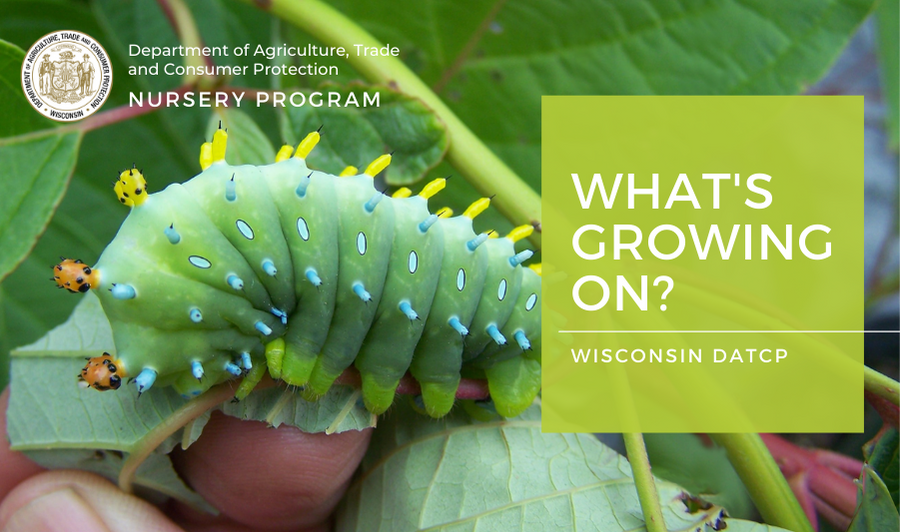 _____________________________________
Dear Wisconsin nurseries, Christmas tree growers, and gardeners:
Growing degree days (GDD)(simple B50) as of August 14 were 1312 in Bayfield, 1482 in Medford, 1552 in Wausau, 1792 in Hancock, 1881 in Green Bay, 1861 in Racine, 2036 in Madison, and 2101 in La Crosse. A few pests in a vulnerable-to-treatment stage include: spruce bud scale crawlers (1300-1500), final applications for flat-headed and round-headed apple tree borers, second generation pine needle scale crawlers (1600-1700), and first applications for locust borer (1800-2100).
Take a moment to read through a few updates from the DATCP nursery and other Plant Protection programs. Please send any feedback, questions, or ideas for future e-news updates to datcpnursery@wisconsin.gov.
Having trouble viewing this email? View it as a Web page.
_____________________________________
|
|
|
The U.S. Department of Agriculture (USDA) has designated the month of August as “Tree Check Month” for the invasive insect Asian longhorned beetle (ALB) because this is the best time of year to find adult beetles. You can help protect our forests by taking a walk around your property or neighborhood to check trees for the beetle and the damage it causes. The sooner we find infestations, the sooner we can implement control strategies to limit spread and work towards elimination of this pest.
ALB is an invasive beetle that tunnels its way throughout tree trunks and branches. Infested trees do not recover and eventually die. In its larval form, ALB begins tunneling into trees to feed during the colder months. The insect matures into adulthood during warmer months as it chews its way out of a tree. ALB attacks many hardwood species in the U.S., such as maples, elms, buckeye, ash, birches, and willows, with confirmed infestations in Ohio, Massachusetts, New York, and South Carolina. Trees impacted by ALB are safety hazards since the beetle tunneling hollows and weakens many areas of a tree. Infested trees can more easily fall over or drop branches, especially during storms.
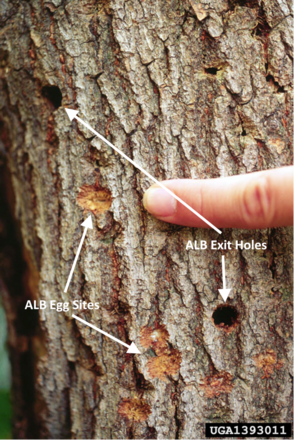
Be on the lookout for:
- Round exit holes in tree trunks and branches about the size of a dime, or smaller.
- Shallow oval or round scars in the bark where the adult beetle chewed an egg site; sap may weep from these areas.
- Sawdust-like material (or frass) on the ground around the tree or in the branches.
- Dead branches or limbs falling from an otherwise healthy-looking tree.
- The insect itself (black and white antennae that can be longer than the insect’s body; a shiny black body with white spots roughly 1” to 1 ½” long; six legs; and feet that can appear bluish-colored.)
|
ALB can sometimes be confused with the native white-spotted pine sawyer beetle, AKA pine sawyer beetle (see images below), that is typically found feeding on stressed conifers rather than hardwood species preferred by ALB. A distinguishing feature of the pine sawyer beetle is the white dot between the wing covers (see yellow box on right image) that is not present on ALB.
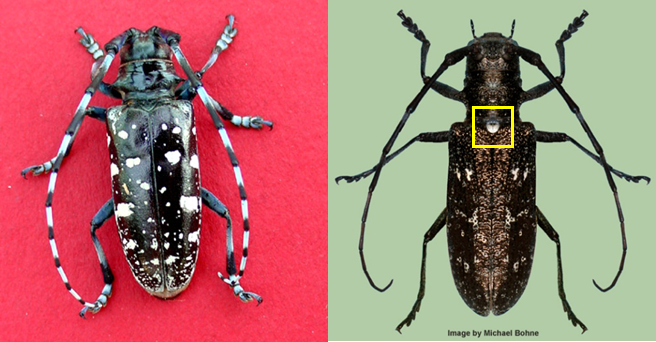 ALB (left) and whte-spotted pine sawyer beetle (right) females. Males of both species typically have antennae longer than the insect's body | University of Vermont
This destructive and invasive pest is yet another reason we regulate firewood movement in Wisconsin. Buying and burning locally is one of the best ways to prevent pests from spreading in our landscape. However, DATCP-certified firewood is designated as safe to move in the state. Read more about Wisconsin’s firewood regulations and other resources on firewood best management practices through our webpage: DATCP Home Moving Firewood in Wisconsin
If you think you found ALB or its tree damage, take pictures and report it! You can also collect suspicious beetles in a container and freeze them, which helps preserve the insect for later identification by state or federal officials. You can report ALB by calling DATCP at (866) 440-7523 or USDA-Animal and Plant Health Inspection Service at (608) 286-3604. You can also report online using the following link: USDA APHIS | Report It.
_____________________________________
|
|
|
DATCP is cautioning landscapers, homeowners, and nursery industry personnel to watch for symptoms of boxwood blight, a disease that poses a serious threat to the nursery trade and to boxwood landscape plantings. Boxwood blight is caused by the fungus Calonectria pseudonaviculata and impacts boxwood shrubs, leading to leaf loss, branch dieback, and shrub death. Pachysandra can also be affected by this pathogen.
Boxwood blight was recently detected at a retail nursery in Walworth County. This disease was first confirmed in Wisconsin in 2018 and is still considered an emerging threat in the state.
When purchasing new boxwood plants, closely inspect plants for symptoms and isolate new plants from existing boxwood and pachysandra plantings for at least one month. A complete list of recommendations is available on DATCP’s Boxwood Blight page.
Symptoms of Boxwood blight
The most noticeable symptoms include brown leaf spots with black necrotic edges that enlarge and merge (see image below), with infected leaves falling off the branch. Black streaks on stems and branch dieback may also be observed (see second image below). During humid weather, white fungal structures may be visible on symptomatic leaf undersides and stems.
|
|
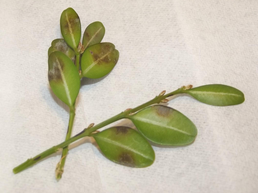 Symptoms of Boxwood blight include brown leaf spots that enlarge and merge. Photo credit: Sandra Jensen, Cornell University, Bugwood.org
|
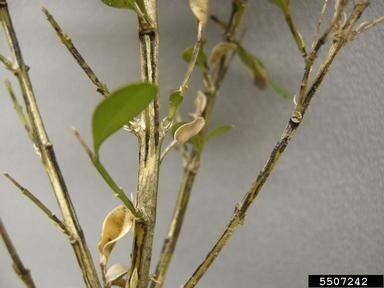 Black streaks on stems caused by Calonectria pseudonaviculata. Photo credit: Mary Ann Hansen, Virginia Polytechnic Institute and State University, Bugwood.org
|
|
|
There are several other pathogens that cause similar symptoms to boxwood blight but are not as destructive or impactful to the nursery industry. These include Volutella blight (caused by Coccinonectria pachysandricola, Pseuduonectria buxi and Pseudonectria foliicola) and Macrophoma leaf spot (caused by Macrophoma candollei).
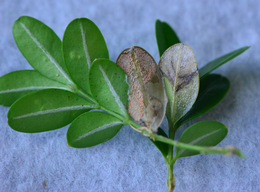
Symptoms of Volutella blight
Infected leaves turn yellow or bronze and stay attached to stems. Affected branches have loose bark, wood discoloration, and dieback. Salmon-pink fungal fruiting bodies can be visible on impacted leaves and stems in humid weather. Tissues damaged by winter injury are most often affected by Volutella blight. (Image left: Pink fungal fruiting bodies of Volutella blight on the left leaf, and white fungal fruiting bodies on the right leaf of boxwood blight, David L. Clement, University of Maryland, Bugwood.org)
|
|
Symptoms of Macrophoma leaf spot
Affected plants produce leaf spots and straw-colored leaves with black, raised fruiting bodies (Image right: Black, raised fruiting bodies of Macrophoma leaf spot on boxwood. Photo: David L. Clement, University of Maryland)
|
|
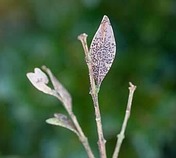 |
If you suspect your plants may be infected and are a licensed nursery grower or dealer, contact DATCP’s Nursery Program at (608) 516-7617 or datcpnursery@wisconsin.gov. If you are a homeowner or landscaping professional, contact the University of Wisconsin-Madison Plant Disease Diagnostic Clinic at https://pddc.wisc.edu/.
_____________________________________
|
|
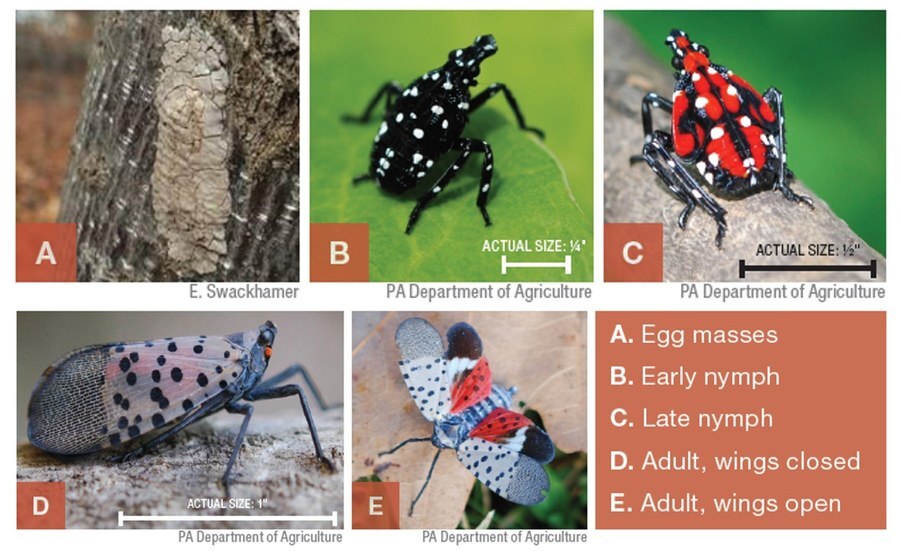 Spotted Lanternfly life stages | E. Swackhamer (image A) PA Dept. of Agriculture (images B, C, D, E)
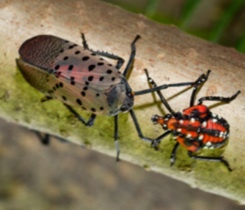
Spotted lanternfly (SLF) (Lycorma delicatula) is an invasive planthopper from east Asia that feeds on plant sap, weakening their plant hosts, and producing a sticky substance called honeydew. It is particularly destructive to grapevines and young saplings. It has quickly spread throughout the eastern United States and has recently been found in the Midwest (Ohio, Michigan, Indiana). While it has not yet been found in Wisconsin, we are constantly on the lookout for this pest. If you receive any goods that are shipped in from a spotted lanternfly-infested state, it’s a good idea to keep a look for these conspicuous little bugs. (image upper left: adult and 4th instar nymph of the spotted lanternfly, USDA Pest Alert 2019)
This time of year, we are particularly watching for signs of 4th instar nymphs and the adult lanternfly. The 4th instar nymph will be red and black with white spots. They feed on a large variety of plant material and are quick to jump if disturbed. Adults are about one inch long and feature tan outer wings with black spots. The inner wings contain a mix of white, black, and red markings. They can be found feeding on many hardwoods such as maple, cherry, willow, apple, or on the invasive tree-of-heaven.
If you think you see any sign of SLF in Wisconsin, report it right away online or call our pest hotline at (866) 440-7523.
|
_____________________________________
|
|
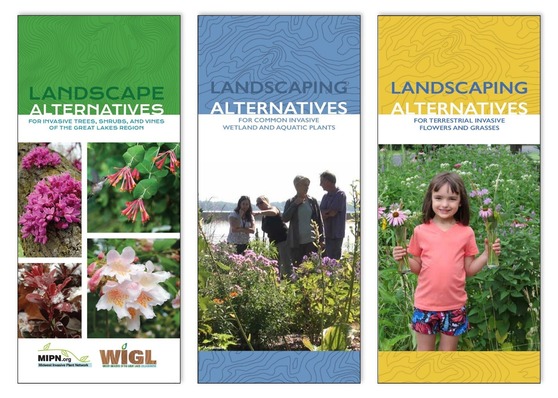 New Landscaping Alternatives brochures | DNR image
Wisconsin and Minnesota recently partnered to create two brochures that showcase alternative landscaping solutions to invasive plants. These brochures are created to complement the Landscape Alternative brochures for Invasive Woody Plants created by MIPN (available here). One of the new brochures covers aquatic and wetland plants and can be found here. The other new brochure covers flowers and grasses and can be found here.
Each brochure contains information on the importance of avoiding invasive species and choosing low-risk or native alternatives instead. The brochures contain tables of suggested alternatives to common invasive gardening plants, as well as some growth characteristics for each suggested species. We aimed to choose a variety of plant types that are available in the trade and grow well in the Midwest. We hope to distribute these brochures widely so they can be helpful to both businesses and consumers.
Currently, MIPN’s woody brochure and our new aquatic brochure are available to order in print. The new flowers and grasses brochure should be available by the end of August. To order, email DNRAISInfo@Wisconsin.gov with which brochures you want to order, how many, and a shipping address. There is no cost.
-Guest contributor Liz Tanner, WI-DNR
_____________________________________
|
|
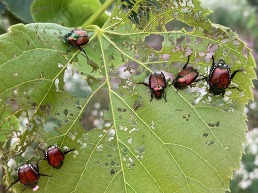 Japanese beetle feeding on many trees, shrubs and vines around the state
|
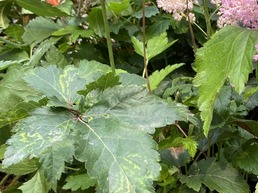 Tobacco Rattle Virus on astilbe in Kenosha County
|
|
 Fireblight on crabapple in Jackson County
|
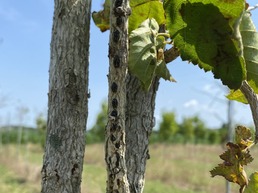 Eastern Filbert Blight on Turkish hazelnut in Dodge County
|
|
 Woolly apple aphids on hawthorn and crabapples in SE counties
|
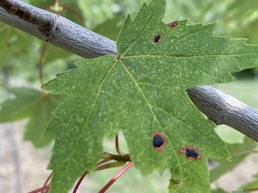 Tarspots on maples around the state
|
|
|
_____________________________________
|
|
|
|
|